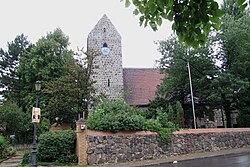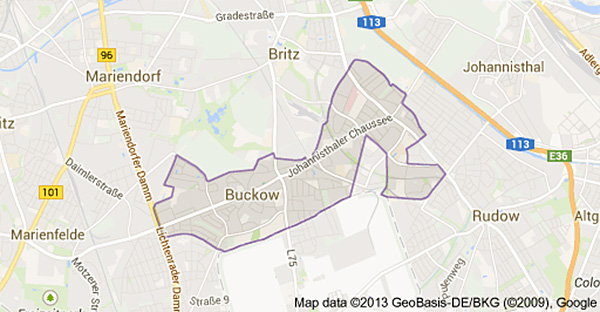Buckow (Berlin)
Buckow [ bu ː ko ː ] is one of Berlin's Neukölln district, which consists of two separate parts.
Location
Buckow located on the southern outskirts of Berlin. It is separated from the Gropius city into two parts.
Buckow 1 is the larger western part. It lies between the Gropius city in the east, the district of Britz in the north and the villages of Marie village and Lichtenrade of the district Tempelhof- Schöneberg in the west. To the south is the border of Berlin to Großziethen, a town of Brandenburg municipality of Schönefeld. The eastern part of Buckow 1 corresponds approximately to the area of the medieval and early modern village Buckow. The area on Quarzweg and west of it is referred to as New Buckow.
Buckow 2 is the smaller northeastern part. It lies between Britz, Rudow and Gropius city.
History
Around 1230, German settlers founded Buckow as Angersdorf. Since no late Slavic settlement traces have been found so far archaeologically in Buckow, it can be assumed that the newcomers took over a Slavic place names ( buk: the copper beech ). The village church was built in the late 13th century. 1373 found the place its first documentary mention. The Country Book of Charles IV of 1375 has for Buckow from 52 ½ hooves, two parish hooves. The village had Krug ( taberna ) and windmill, suggesting a degree of prosperity. A similar note is the village church, as the village churches with Westbauten belong to the most costly plan type.
In 1806, French troops had occupied for four years the village Buckow. 1900 Buckow station was opened the Rixdorf - Mittenwald Railway, which lay east of the village. 1913 extended the Great Berlin tram their network down into the center of Buckow.
The village was incorporated in 1920 as part Buckow Neukölln in Berlin. Passenger traffic on the railway line was discontinued in 1955, the last tram ran in 1964.
The United Britz -Buckow - Rudow was created in 1972, which received the name of Bauhaus founder Walter Gropius. 1976, Gropius City was completed and separated in 2002 as a separate district.
Attractions
Hans -Martin- Helbich settlement
The Hans -Martin- Helbich settlement located in Buckow 1 and extends from Alt- Buckow south to Gerlinger Straße. It was built in 1974 and belongs to the protestant church Old and New Buckow Buckow. It is named after Hans -Martin Helbich, the then General Superintendent of the Sprengel I ( included West Berlin) of the Evangelical Church in Berlin- Brandenburg. The housing development with over 1,000 homes is recreational and shopping area at the same time, since it includes its own sledding hill, lots of meadows and fields, but also a shopping center with several shops. In addition to the settlement is a closed because of asbestos exposure School, which stood empty since 1990 and was demolished in late 2010 was.
Village church Buckow
The village church Buckow originated in the late 13th century; the wooden lock bar in the west portal allowed a dendro of 1304. It was built of fieldstone. It consists of a hall with a ship wide querrechteckigem west tower. This floor plan is very rare ( eg on the Barnim only 2.6 percent of all medieval village churches).
It was rebuilt several times in the following centuries. During renovation work in the 20th century came to light remains of medieval murals, which can be seen even today in a very pale fragments in the ribbed vault of the church. Most clearly a Last Supper in the front part of the church can be seen.
To the ringing of the church is also an undated bell from the 13th or 14th century, is the oldest of all Berlin village church bells because of their special form. It is slightly out of tune after a long use and is only used as a supper bell.
→ See also: List of cultural monuments in Berlin- Buckow. Here are the names entered in the list of monuments of Berlin cultural monuments.
Others
Every year on the third weekend in August takes place the Buckower straw bale hard in this district. It involves a three-day public ceremony, which takes place under the open sky on the field of a locally based farmer. The field is located southwest of the intersection Buckower Damm / Gerlinger Straße.
The event originated in 1995 from a neighborly idea of the farmer Werner Mette. He is one of the last fully working farmers union of Berlin and just wants the city dwellers close to bring this festival to agriculture. Numerous confident and enthusiastic about the idea of participants and supporters extended the circle of this nature-loving " village meeting ". The result was - not least through the active participation of the population - the concept of Buckower straw bale festival.
The lease agreement for Bauer Mette should be terminated at the end of 2013, there will be built a loosened and pleasantly landscaped urbanization with high environmental standards at affordable prices on the designated as building land areas according to the Senate Department for Urban Development and Environment. The straw bale festival was held in 2013 for the last time, but it is now also announced for 2014 again.









